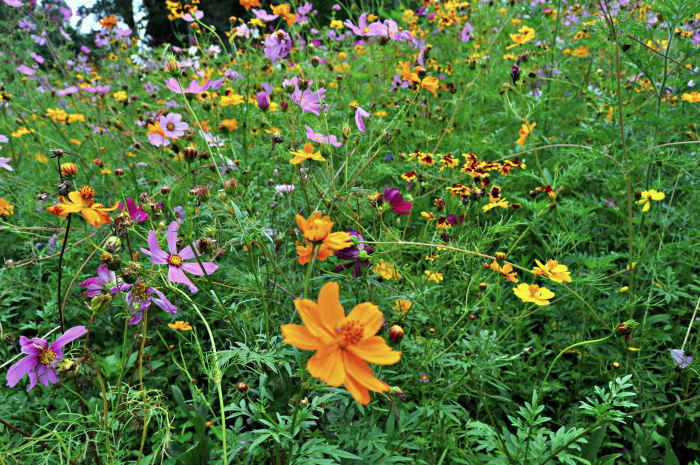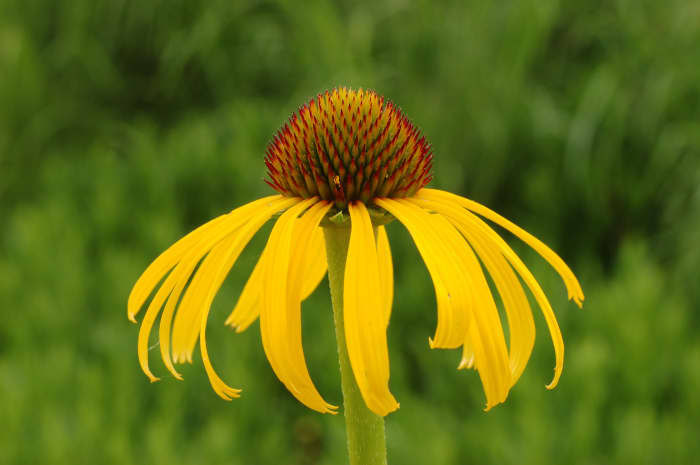Native American Gardening Three Sisters
Jule Romans has been gardening with native wildflowers for over 15 years. She loves to share knowledge about her favorite native plants.

Native wildflowers, including endangered species.
Virginia State Park Staff
Endangered native wildflowers are good for the environment and good for gardeners. They are also very easy to grow. Most endangered native wildflowers have an exact "twin" that is commonly sold in garden stores. Gardeners can achieve the same effect with native flowers as they can with traditional garden plants. Additionally, planting endangered native wildflowers increases the quality of the environment while making a garden more beautiful. The best thing about endangered native plants is that they are perfect for beginning gardeners.

Lead plant is an endangered native woody plant or shrub
Denis Prevot
1. Lead Plant (Amorpha Canescens)
Good alternative to: Tamarisk, mimosa, spiraea
Best for: Experienced gardeners
The foliage is silvery green and flowers are purple, growing in large spikes. The shrub will grow between 3–6 feet tall. It will rarely need pruning.
Lead plant will not flower or bloom the first year. These bushes are quite slow to mature. For this reason, beginning gardeners may want to combine plantings with faster-growing perennial native flowers like purple coneflower or wild larkspur.
It is a very long-living shrub that does very well in dry areas and is a host for the caterpillars of the lead plant moth.

Yellow coneflower offers benefits for songbirds, as well as a splash of bright color.
Derek Ramsey
2. Yellow Coneflower (Echinacea Paradoxa)
Good alternative to: Teddy bear sunflower, lady's mantle, yellow daylily
Great for: Beginning gardeners
This native flower is not the same plant as the yellow coneflower plants that are created in a lab. This version of yellow coneflower has drooping petals and a deep brown center. It will grow 2–3 feet tall.
Native flowers in general are very drought tolerant and yellow coneflower is no exception. Also, goldfinches love the seed of yellow coneflower. Leaving the plant standing in fall will attract finches throughout the winter months.

Scarlet globemallow has a similar appearance to poppies.
Jerry Friedman
3. Scarlet Globemallow (Spherule Coccinea)
Good alternative to: Foxglove, amaranth, oriental poppy, snapdragon
Great for: All gardeners
These native flowers are fairly short, growing only 12 inches tall. They are good for rock gardens and other dry places.
Since scarlet globemallow tends to sprawl out rather than up, it can give the same effect as a groundcover plant. It needs a great deal of sun daily. DO NOT water or fertilize these native flowers.

Prairie blue sage is a better choice than Russian sage.
Krzysztof Ziarnek
4. Prairie Blue Sage (Salvia Azurea)
Good alternative to: Russian Sage, chicory
Great for: Beginning and experienced gardeners
This one is also known as prairie sage or pitcher sage. It grows 3–5 feet tall, so use it in the back of the border. Plant in full sun and it will bloom from summer through fall with bright blue flowers.
Prairie sage attracts bumblebees and butterflies. It is also a host/nectar plants for checkerspot butterflies. The flowers are not a consistently showy, so it will do better with companion native flowers. It will look best closely planted with tall grasses or other tall blooming plants. It may need staking in traditional garden conditions.

Butterfly guara has a delicate appearance, but like most native plants, it is quite hardy in natural conditions.
J.Gad, via Wikimedia Commons
5. Butterfly Gaura (Gaura Lindheimeri)
Good alternative to: Gladiolus, foxglove, dianthus, cornflower
Best for: Somewhat experienced gardeners
This plant is drought tolerant and will grow as a perennial in most zones (5–9). It will reach 3–5 feet in height and its flowers are white and plentiful. It also attracts butterflies and bees.
Guara will tolerate many different sun exposures and soil conditions. Try it anywhere. Don't worry if seedlings take some time to come up. It can germinate in one to three weeks. Some seeds take the full time.

Showy fleabane is one of many other alternatives that are better than traditional garden choices.
Anneli Salo
Other Native Wildflowers That Are Good Alternatives
Here are a few more selections that are great alternatives to commonly suggested wildflowers.
- Prairie Aster (Machaeranthera Tanacetifolia): Good alternative to bachelor buttons, painted daisy, China aster, blue petunias. Great for beginners.
- Showy Fleabane (Erigeron Speciosus): Good alternative to Queen Anne's lace, kingfisher daisy, blue fringe daisy. Also great for beginners.
- Nodding Onion (Allium Cernuum): Good alternative to non-native alliums. Good for beginners and easy to grow.
- Little Bluestem (Schizochyrium Scoparium): Good alternative to pampas grass. Great addition to any prairie-style planting. Great for beginners. Very showy in fall.
- Fringed Sage (Artemisia Frigida): Good alternative to silver artemisia, dusty miller, lamb's ear. Good for gardeners of all experience levels.
- Verbena (Verbena Strica): Good alternative to alyssum, brachycome, mint. Best for somewhat experienced gardeners.
- Compass Plant (Silphium Lacinatum): Good alternative or companion to the European mammoth sunflower. Especially good for birds and butterflies. Better for experienced gardeners, as it is very tall and needs to be placed carefully within garden design.
Finding Endangered Native Wildflowers Isn't Always Easy
Mainstream garden sites don't always offer the best variety in native plants. Finding seeds for endangered wildflowers can be even more difficult in a traditional store. Even the less-likely places can get very confusing. Specialized native and prairie flower stores tend to rely on scientific names to identify the plants they sell. For the beginning gardener, this dilemma can become very frustrating.
Native Wildflowers Are Great for Beginning Gardeners
The worst part about this problem is that endangered native wildflowers are IDEAL for beginning gardeners. No one takes up gardening with the intention of studying a new language. Nor does anyone start growing flowers because they want to engage in debates or arguments about the relative merits of Asclepias incarnata over Buddleia davidii. No, people start growing endangered native wildflowers because they love beauty, enjoy the outdoors, and want to create something lasting and pretty.
Endangered Native Wildflowers Can Thrive in the Garden
That's why these flowers are perfect for beginners. Beginning gardeners need easy-to-grow plants that can stand up to natural conditions. That is exactly what wildflowers can do. These hardy plants adore the soil and climate conditions that already exist. They don't need extras. Native flowers coexist with insects. They neither need nor want pesticides. Native flowers spread vigorously in most ordinary gardens. They don't need special tending or encouragement to thrive and fill garden space.
This content is accurate and true to the best of the author's knowledge and is not meant to substitute for formal and individualized advice from a qualified professional.
© 2021 Jule Romans
Native American Gardening Three Sisters
Source: https://dengarden.com/gardening/Endangered-Native-Wildflowers-Garden
Posted by: anthonypernihiststo.blogspot.com

0 Response to "Native American Gardening Three Sisters"
Post a Comment